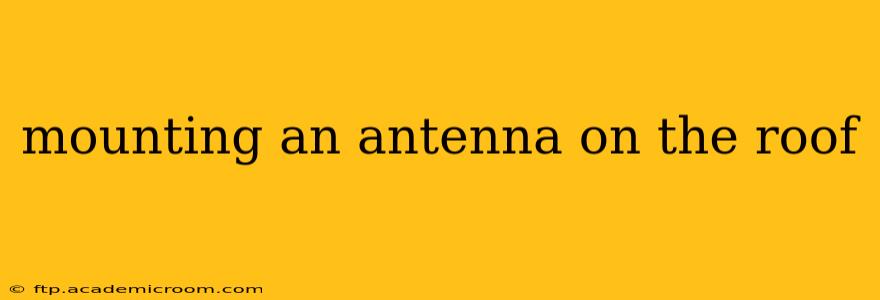Mounting an antenna on your roof can significantly improve your TV reception or expand your Wi-Fi range. However, it's a project that requires careful planning and execution to ensure safety and optimal performance. This comprehensive guide covers everything from choosing the right location to securing your antenna safely and efficiently.
Choosing the Right Antenna and Location
Before you even think about climbing onto your roof, you need to select the appropriate antenna for your needs and identify the ideal mounting spot. The type of antenna (TV, Wi-Fi, etc.) will dictate its size and mounting requirements. For TV antennas, consider the direction of broadcast towers and the distance to them. A professional installer can help with this.
For Wi-Fi antennas, consider the areas you need to cover and any obstructions. A directional antenna is best for focused coverage, while an omni-directional antenna provides broader coverage.
Finding the best location involves considering:
- Obstructions: Trees, buildings, and even hills can significantly impact signal strength. Aim for an unobstructed line of sight to broadcast towers or the areas you want to cover with your Wi-Fi.
- Roof type: The material of your roof (shingles, tile, metal) will influence the type of mounting hardware you'll need.
- Height: A higher antenna generally receives a stronger signal, but safety is paramount. Avoid unnecessarily high placements that would make maintenance dangerous.
- Accessibility: Choose a location that's relatively easy to reach for maintenance and adjustments, even if that means slightly compromising on signal strength.
What Tools and Materials Will I Need?
The specific tools and materials will vary depending on your antenna and roof type, but here's a general list:
- Appropriate antenna: Make sure it's compatible with your needs and weather conditions.
- Mounting mast: This will raise the antenna above the roofline for improved reception.
- Mounting hardware: This includes bolts, nuts, screws, brackets, and potentially sealant to ensure a weatherproof seal. Choose materials that are compatible with your roof type.
- Ladder (and possibly roof jacks): A sturdy ladder is essential for safe access to your roof. Roof jacks can enhance stability.
- Drill: You'll likely need a drill to install the mounting hardware.
- Wrench and screwdrivers: Appropriate sizes for your mounting hardware.
- Level: To ensure your antenna is mounted straight.
- Safety gear: This includes gloves, safety glasses, and a hard hat. If working at a significant height, consider a safety harness.
- Cable: High-quality coaxial cable for TV antennas or appropriate cabling for Wi-Fi.
How to Safely Mount an Antenna on a Shingle Roof
Mounting an antenna on a shingle roof requires extra care to prevent damage to the shingles. Here's a step-by-step guide:
- Plan your location: Mark the exact spot where you'll mount the antenna, ensuring it meets the criteria discussed above.
- Prepare the area: Carefully remove any shingles that will be under the mounting bracket.
- Install the mast mount: Securely attach the mast mount to the roof rafters, using appropriate fasteners and sealant.
- Attach the mast: Install the mast to the mount, ensuring it's plumb.
- Mount the antenna: Attach the antenna to the mast, making sure it's securely fastened and aligned correctly.
- Connect the cable: Carefully run the cable from the antenna to your receiver, ensuring a waterproof connection.
- Replace the shingles: Replace the removed shingles and apply additional sealant to ensure a weather-tight seal.
How to Safely Mount an Antenna on a Metal Roof
Metal roofs typically require different mounting hardware than shingle roofs. Consult a professional if unsure. Using appropriate fasteners designed for metal roofing is critical to prevent leaks.
What are the Potential Risks of Mounting an Antenna Myself?
Working on a roof is inherently risky. Potential hazards include:
- Falls: This is the most significant risk. Always use a sturdy ladder and consider safety harnesses, especially for taller roofs.
- Electrical shock: Be aware of overhead power lines and keep a safe distance.
- Weather conditions: Avoid working in inclement weather.
- Roof damage: Improper installation can cause damage to your roof.
How Much Does it Cost to Hire a Professional Antenna Installer?
The cost of hiring a professional antenna installer varies depending on your location, the complexity of the installation, and the type of antenna. Expect to pay a few hundred dollars for basic installation.
What Permits Do I Need to Install a Roof Antenna?
Permit requirements vary by location. Check with your local building department to determine if you need a permit before proceeding.
This guide provides a general overview. Always prioritize safety and, if uncertain about any aspect of the installation, consult a qualified professional. Remember that safety should always be your top priority. Improper installation can lead to damage, injury, or even death.
